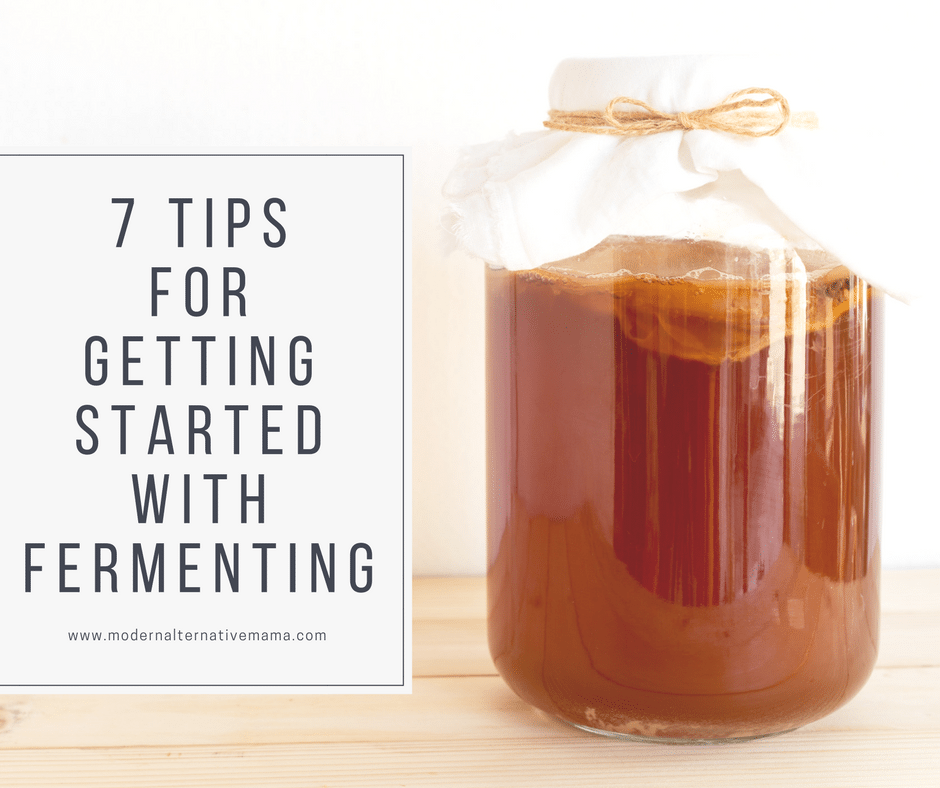I’ll be the first to say this: I’m no fermentation expert. If you’re looking for that, you would do better to talk to Wardee of GNOWFGLINS or Jenny of Nourished Kitchen. They are masters of fermenting anything.
But sometimes, we learn best not from masters, but from those who have struggled and come to a place where they are successful. Not amazing, but they do what they do well. That’s me! I don’t do vegetable or fruit ferments (yet) but I do several other types of ferments, popular ferments, well. Some of them I struggled and failed with quite a few times before I made them successful — so I have a whole bunch of “what not to do” tips.
If you’re just getting started with fermentation, or even just thinking about getting started, this is what you need to know.
Start Fermenting Today
The biggest hurdle you will face with fermentation is starting it. It seems intimidating. It seems like it’s easy to fail or just plain old weird. But if you are intrigued and you want to do it, then — do it! You won’t know what it’s like until you get started.
Honestly, it seems harder than it is. I spent hours reading and researching and trying to understand before jumping in, and you really just need to try it. That’s the only way! Don’t let yourself be so intimidated that you don’t even start.
Pick one thing (just one) and promise yourself, “I am going to do this.” Read the tips below, then do it. For real.
Tip #1: Use Quality Starter Cultures
There are many ways to obtain starter cultures, most of them good. But there are also bad ways.
Good ways: buy from a reputable source (Cultures for Health is a good place, also Just So Products), get it from a friend (whose culturing practices you know and who could even help you if needed).
(Possibly) Bad ways: Order from a stranger over the internet. You might get a great culture (I have before), but you might get one that’s been exposed to chlorinated water, GMO sugar, etc. Always ask what they feed the culture before buying.
There are ways to start sourdough without a culture at all, just by capturing wild yeasts from your kitchen or using grape skins. Do not do this if you are a newbie! Buy a quality culture or get one from a friend, something that’s well-established. The wild yeasts may not be good ones for your sourdough and you might end up with something that smells or tastes bad, fails, or even grows mold. Get a quality culture; you will be glad you did!
Tip #2: Use Glass Jars
For most any type of fermenting, you will need glass jars. Do not use plastic! You may be able to use ceramic in some cases, but be careful the glaze doesn’t contain lead. Glass is the simplest, cheapest, and safest. I use pint, quart, half-gallon jars, and gallon jars, depending on what I am making. Mason jars are easy to obtain and fine to use for any of the first five listed below. The fruit/veggie ferments — it depends on who you ask (and apparently is quite controversial!). (Some say that fruit/veggie ferments can be done in open crocks. Others say they must be anaerobic and require special equipment. But if you want to jump in and don’t have any health concerns, a simple mason jar is a fine place to start.)
- Yogurt: Pint or quart jars
- Milk kefir: Pint or quart jars
- Water kefir: Quart or half-gallon jars
- Kombucha: Gallon jars
- Sourdough: Any size (I usually use quart)
- Fruit or vegetable ferment: Any size (quart is probably most common)
Tips #3: Use Wooden Spoons
For some of these cultures, metal can negatively impact them. In general, it’s best to use wooden or bamboo spoons. Plastic does in a pinch. I do use metal for sourdough often, because it’s not so important there. I don’t use metal in any of my kefir, yogurt, or kombucha cultures, though. In general, shoot for wood.
Tip #4: Read Directions Carefully
Each of these cultures has its own little quirks. For that reason, read the directions that come with it, and read them carefully. Then follow them. If it says to add an eggshell, do it. If it says to add the liquid that comes with the culture, do it. If it says to dump out some of the culture, do it. There’s a good reason why! (Says someone who ignored more than half of these instructions, more than once, to my own detriment….)
Store every culture in the fridge when you are not using them. Leaving them on the counter without feeding will cause them to die.
Here are some basic tips about each:
- Water Kefir: Feed it approximately 2 tbsp. “grains” (culture), 1/4 c. sugar, and 3 – 4 cups water. It takes 18 – 36 hours to ferment. Add an eggshell or a bit of molasses to every 2nd or 3rd batch (some do it in each). I ferment this with a lid on, sealed; others ferment with a loose covering.
- Milk Kefir: Add 1 – 2 tbsp. “grains” (culture) to about 2 c. milk. Don’t let it get too warm. Keep this one going outside the fridge as much as possible, because the culture can take on a bitter, alcoholic flavor if it sits too long. Rinsing it in milk can help fix this issue.
- Kombucha: Brew 6 tea bags in a quart of water (for several minutes; remove), then add 1 c. sugar and 2 quarts of water to cool. Pour it into a gallon-sized glass jar with at least 1/2 c. brewed kombucha + SCOBY. Brew for 7 – 10 days initially, tasting after about 5 – 6 to see where you like it. This can be drunk straight from the jar or bottled with additional flavors.
- Yogurt: Heat the milk to 180, then cool to 115 before culturing for thick yogurt. Use 2 tbsp. yogurt or culture per quart of milk. Transfer jars from culturing to the fridge without stirring or shaking until completely cool.
- Sourdough: Feed every 12 hours to maintain a good culture, or every 8 hours for three feedings right before making bread. Keep it in the fridge and feed once a week (allowing 12 hours for the yeast to eat the new flour before putting away) if you are not going to bake often. Keep the starter on the thicker side (if liquid is appearing on the top of the starter within a couple hours of feeding, it’s too thin). Use up or dump out extra starter, especially when getting the culture going initially. You want roughly equal amounts of starter, flour, and water (you can use less flour and water vs. starter once the culture’s well established, but you may need to feed it more often if you want to bake. It’s the gases produced by the yeasts and bacteria eating the flour that rises the bread).
Tip #5: Use Quality Ingredients
Good quality ingredients will help you succeed. That means filtered water, clean milk, organic cane sugar (white is fine), organic whole wheat flour, organic tea, etc. I buy organic sugar and whole wheat flour at Costco, tea at Mountain Rose Herbs (great prices, cheaper than regular grocery store tea), and I filter my water with a Berkey from United Environmental Solutions.
Plus, when you’re making food at home, from scratch, you can totally control what goes in it — why not make it the best you can? Often, top-quality homemade is cheaper (sometimes significantly) than “decent” store-bought.
Tip #6: Find a Warm Spot and Patience
Most of these cultures do best around 70 – 72 degrees. They will work between about 65 and 78, though. If they get too hot, they will culture too quickly and become sour, bitter, and alcoholic (or vinegary). If it’s really too hot, like over 115 – 120, the cultures will die. If it’s too cold, they will culture very slowly and flavor will be harder to control, and in some cases, pathogenic bacteria could grow before the good stuff takes over.
If your home is cold in the winter, you might try:
- On a heating pad (watch the temp. closely)
- On top of the fridge
- Near the stove
- In a bathroom, or other non-drafty place
- Inside the oven with the light on
I keep my sourdough in my oven with the light on, which seems to work really well. If you have several cultures, you will want to space them out. I keep my kombucha on a counter at one end of my kitchen, and my kefirs (sealed) on either side of my stove on the other side. You can get creative with your ferments, and they don’t have to stay in the kitchen. Wherever you have space is fine!
And be patient. These ferments can take anywhere from a handful of hours to weeks to ferment properly. Wait for them. It’s worth it.
Tip #7: Try, Try Again
I’ve failed at sourdough at least four times, maybe five — but now I have a successful starter and have baked quite a bit with it. I’ve failed at water kefir at least as many times, though I’ve had successful batches too. I’ve had many less-than-stellar batches of kombucha (but still drinkable).
But I keep trying. You should too. You might get busy and forget about your culture until it is dead. You might make a mistake and have something come out poorly. This is okay!! It happens to everyone, even experienced fermenters.
What’s Your First Project?
All that’s left is for you to get started! So what will your first project be?
Want to try kombucha? Check out my kombucha video for more information.







